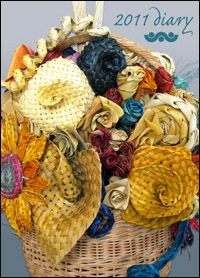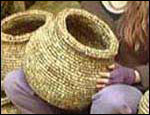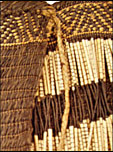Being creative with fibre
9 May 2012Click here to visit an upgraded version of this blog post on my new website at alibrown.nz.
 Creative Fibre — once known as the New Zealand Spinning, Weaving & Woolcrafts Society — seems to be evolving from a focus on traditional woven woolcrafts to encompass flax, felt, free-form designs and any and every use of fibre for creative purposes. Last year’s Creative Fibre diary featured a basket of my flax flowers on its cover and this year I was invited to give two demonstrations of flax basket-weaving at the Creative Fibre Festival in Marlborough. It was my first visit to a Creative Fibre Festival, and the whole festival gave off a feeling of creative energy. As I listened to the presenters, I automatically thought of the way the ideas they applied to other fibres could be transferred to the process of flax weaving.
Creative Fibre — once known as the New Zealand Spinning, Weaving & Woolcrafts Society — seems to be evolving from a focus on traditional woven woolcrafts to encompass flax, felt, free-form designs and any and every use of fibre for creative purposes. Last year’s Creative Fibre diary featured a basket of my flax flowers on its cover and this year I was invited to give two demonstrations of flax basket-weaving at the Creative Fibre Festival in Marlborough. It was my first visit to a Creative Fibre Festival, and the whole festival gave off a feeling of creative energy. As I listened to the presenters, I automatically thought of the way the ideas they applied to other fibres could be transferred to the process of flax weaving.
The key guest presenter, Kim Thitichai from the UK, a delightful, energetic speaker, works with heat tools on materials that are heat distressable. Heat stressing doesn’t readily transfer to flax weaving but the key for me in her presentation on design was her discussion about “engaging directly with the materials”. Sometimes, no matter how well we plan things when working creatively, the process doesn’t go according to the plan. The materials themselves can dictate the way the project ends up and — if one goes with the flow — the results can be innovative and dramatic. I find myself regularly using this technique when I’m designing though I generally call it playing. A good example of this is the flaxwork Wave pictured above, which I created for an exhibition in the seaside town of Lyttelton. It’s made from a flat woven square of multi-coloured blue flax strips, and although I wasn’t at all sure how it was going to end up, it does seem to capture a sense of the shape and motion of a wave.
Sometimes, no matter how well we plan things when working creatively, the process doesn’t go according to the plan. The materials themselves can dictate the way the project ends up and — if one goes with the flow — the results can be innovative and dramatic. I find myself regularly using this technique when I’m designing though I generally call it playing. A good example of this is the flaxwork Wave pictured above, which I created for an exhibition in the seaside town of Lyttelton. It’s made from a flat woven square of multi-coloured blue flax strips, and although I wasn’t at all sure how it was going to end up, it does seem to capture a sense of the shape and motion of a wave.
A World of Wearable Arts award winner, Sarah Hornibrooke from Golden Bay, who regularly uses flax in the creations that she enters in the competition, gave some tips for those wishing to enter it. Sarah advises that the garment must be well-made as it is worn in a number of shows and it needs to stay together, as well as being reasonably easy to get on and off.  The garment should look good close up and at a distance as the garments are closely scrutinised by the judges, but it also needs to have impact when are worn during the show. Often the winner is a very simple idea. It’s also helpful for the garment to have a catchy name. Deb Price, who often works with Sarah on entries, was the Montana Supreme Award Winner in 1995 with an twined-flax creation, Moko. One of Deb’s twined pots is pictured above.
The garment should look good close up and at a distance as the garments are closely scrutinised by the judges, but it also needs to have impact when are worn during the show. Often the winner is a very simple idea. It’s also helpful for the garment to have a catchy name. Deb Price, who often works with Sarah on entries, was the Montana Supreme Award Winner in 1995 with an twined-flax creation, Moko. One of Deb’s twined pots is pictured above.
Flax featured in Heather Baskiville-Robinson’s presentation on making paper. Heather took us through the process of making flax paper, and we watched Canadian paper-maker Helen Heibert’s time-lapse DVD on the way that some materials can be their own creators as they change shape over time, a property that Helen specifically  exploits in her creations. This has a parallel in flax weaving where two properties of flax have been exploited to make a skirt, or puipui. Firstly, flax strips curl up into cylinders when they dry, a property which is used in puipui-making to make the long rustling skirt of the puipui. Secondly, the fibres inside the flax take a dye more readily than the leaf itself and this property is exploited to make the geometrical patterns on the garments.
exploits in her creations. This has a parallel in flax weaving where two properties of flax have been exploited to make a skirt, or puipui. Firstly, flax strips curl up into cylinders when they dry, a property which is used in puipui-making to make the long rustling skirt of the puipui. Secondly, the fibres inside the flax take a dye more readily than the leaf itself and this property is exploited to make the geometrical patterns on the garments.
 Flax is an ideal material to be creative with, as it is pliable and sculptural while green but hardens to retain shape as it dries. It also has a strong fibre and it dyes well. Traditional weaving techniques can be used to make something a bit out of the ordinary, like this three-cornered Wind-blown kete.
Flax is an ideal material to be creative with, as it is pliable and sculptural while green but hardens to retain shape as it dries. It also has a strong fibre and it dyes well. Traditional weaving techniques can be used to make something a bit out of the ordinary, like this three-cornered Wind-blown kete.
Why not think about using flax creatively to enter the Creative Fibre competitions for next year. The Far North Award, sponsored by Te Wananga O Aotearoa, of $750 and a Whaka Huia for the most creative use of New Zealand design or materials seems like a particulalrly appropriate category for flax weaving. This year’s winner for the Award is Donna Hitchcox of Timaru with her entry Tuatara Wisdom. It would be great to see flax featuring to a greater degree in this competition as well as in the Wearable Arts Awards. If you have used flax in entries for either of these awards, or any other awards, do send me a photo.
© Alison Marion Brown 2012.


July 21st, 2012 at 5:05 pm
I love the flowers!
July 21st, 2012 at 5:10 pm
I just want to say how do people make this kind of stuff?
If someone is great then would they please give me instructions to make them because when my mum tried to teach me, it didn’t turn out well.
July 22nd, 2012 at 10:35 am
Hello Tanisha
Glad you like the flowers. You can learn how to make the flax flowers pictured on this post, and other styles of flowers, from my book Weaving Flowers from New Zealand Flax. Some of the flowers are quite easy and only take a few minutes to make. The book is available to buy directly from me and the information on how to buy it is on the Book page on this website. There are also instructions online here on how to make one of the types of flowers in the book. The book is written in this style, with step-by-step photographic and written instructions for each of the sixteen flower and foliage designs.
August 3rd, 2012 at 12:01 pm
Hi Ali
Can you please send me a bank account number and the prices of both books weaving flowers and creative weaving, thanks Ngarangi
August 4th, 2012 at 12:22 pm
Hi Ngarangi
Thanks for your interest in my books. The cost of buying both the Weaving Flowers from New Zealand Flax book and the Weaving a large container from New Zealand Flax booklet is $46.30 altogether. This includes the price of both books and the postage and packaging. The bank account to pay into is my Westpac bank account 03–0823–0516382–000. Don’t forget to send me your current postal address.
September 20th, 2012 at 1:58 pm
Hi Ali,
I watched your presentation at the Creative Fibre Fest in Marlborough and stupidly didn’t buy a copy of your book on basket making. I have your original flax flower book and would like to add the basket making book too my collection. I read in the previous post that you mention “weaving a larger container from NZ flax” I assume this is the title. Can you tell me if you have some available and what the cost including postage to Dunedin would be.
cheers
Sue
September 26th, 2012 at 9:22 am
Hi Sue
The booklet I had at the Creative Fibre festival gives instructions on how to weave a large container from New Zealand Flax. It’s $13 which includes postage and packaging to anywhere in New Zealand.
March 4th, 2013 at 7:28 am
Hello Ali,
I am wondering if you might be having a workshop on weaving flowers in Christchurch in the next couple of months.
Thanks, Marianne
February 13th, 2014 at 7:16 am
Hello Ali, I would like to purchase a copy of your How To Weave A Larger container booklet, is it still available? If so could I please have an account number to pay for it online and total cost of the booklet and postage to my address in Hamilton. Thank you.
Regards Judy.
February 14th, 2014 at 6:53 am
Hi Judy
Yes that booklet is available. It’s $15 which includes postage and packaging. The bank account to pay the money into is Westpac 03-0823-0516382-00. Don’t forget to email me your postal address.